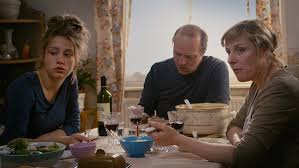
Rome, 1st century BC, a slave, topless and barelegged, stands knee deep in a bath behind his master who is sitting with his back to him, completely naked. The light lathers their bodies in a bronze that compliments their tan complexions. Addressing his slave, the master proceeds to interrogate him about his habits and morals, does he lie? Does he steal? Has he ever dishonoured the gods? To all of these question the slave replies no. The questions are a form of foreplay, a series of appetizers preparing the ground for the main course, “Do you eat oysters?” the master asks; to which the slave replies that he does whenever he can. “Do you eat snails?” the master continues. “No, master.” The young slave replies. “Do you consider the eating of oysters to be moral, and the eating of snails to be immoral?” Thus runs one of the most explicitly coded homoerotic encounters in the history of cinema courtesy of Stanley Kubrick’s direction, Dalton Trumbo’s script, and Laurence Olivier and Tony Curtis’s performances in, you guessed it, Spartacus.

Abdellatif Kechiche fishes in similar waters in his provocative, intense and explicitly homoerotic Blue Is the Warmest Color by having the assured artist Emma tease her young and more inexperienced lover Adèle about the latter’s dislike of oysters, which Emma relishes both literally and as coded female genitalia. In the scene, the two leads are lying on the grass side by side, fully dressed, so absorbed in each other they may as well be an island slowly drifting away under the sun. Delight and a subtle flash of embarrassment cross Adèle Exarchopoulos face in yet another of the myriad close ups that constitute Kechiche’s film. It may not be the film’s subtlest moment, coming in the wake of Trumbo’s daring defiance of 1950s scruples but, the universe of adoration and intimacy in the young actress’s lovely face will touch anybody lucky enough to have experienced requited love. By the end of the scene Adèle is ready to enter the threshold of a new world that will devour her and spit her out forever transformed. She is now ready to taste oysters.

However invested in his lesbian love story (and invested he is), Kechiche’s film is ultimately a character study; a sort of sentimental education for a young working class woman who begins the film wading the troubling waters of her sexual awakening and finishes it almost drowning in them. Blue Is the Warmest Color is a long film, running at almost three hours, and it is exhausting in its uncompromising refusal to breathe for air as it inhabits young Adèle’s development; in that sense, it is utterly novelistic and Kechiche acknowledges that his protagonist must be measured not only in terms of an inner consciousness that is beginning to assert itself, but also against a milieu that is at odds with her passion and, as Kubrick would have it, her taste. For that reason, Kechiche has found in his oysters not just a metaphor for sex between women but also a class signifier, which he deftly uses in a scene that brings the young women for dinner to Emma’s house. Emma’s mother and her partner are bohemian, comfortably off but-unshowy in their tastes; they buy art and display it on the walls, they are discerning and adventurous in their search of white wine, they know Emma is gay and they receive Adèle with open arms and a batch of fresh oysters. The scene is lit in subdued muted gold reminiscent of candlelight; Emma’s mother, warm but inquisitive, tries to disguise her incomprehension about Adèle’s modest and pragmatic ambition to become a primary school teacher. Adèle overcomes her scruples and swallows the oysters that used to disgust her. She has crossed the line that separates her from the worldlier Emma, even if momentarily.

Kechiche sustains his use of food as a class signifier in a mirror dinner scene staged in Adèle’s house. Here Emma is not a lover, but a friend helping Adèle improve her results in Philosophy. Oysters are not on the menu, spaghetti Bolognese –a male and working class coded dish in cinema (not incidentally is it frequently on the menu in Mafia films heavily invested in depictions of masculinity)– have been cooked by Adèle’s father. In this environment, where earning one’s crust is paramount, Emma’s metier is questioned as impractical. She, like Adèle before her, is willing to enter her lover’s world on its own terms, adopting a heterosexual mask and toning down her bohemian streak to please her girlfriend’s parents. Léa Seydoux smiles as she absorbs the spaghetti that run under the charming gap between her teeth. She is more knowing than Adèle and it shows on her face. Kechiche once again proves that he is a great director of character: action and expression meet through the consumption of food. Dinner tables have always been pregnant with silenced truths in classic drama and this scene is a fine addition to that tradition.
Elsewhere Kechiche and co-script writer Ghalia Lacroix prove that it is impossible to write about love without writing about food. I won’t tell you any more. Go see the film and have some food before you sit down for its three-hour run. Be careful not to overeat though: Blue Is the Warmest Color proves that oysters can be far more (ful)filling than spaghetti.











